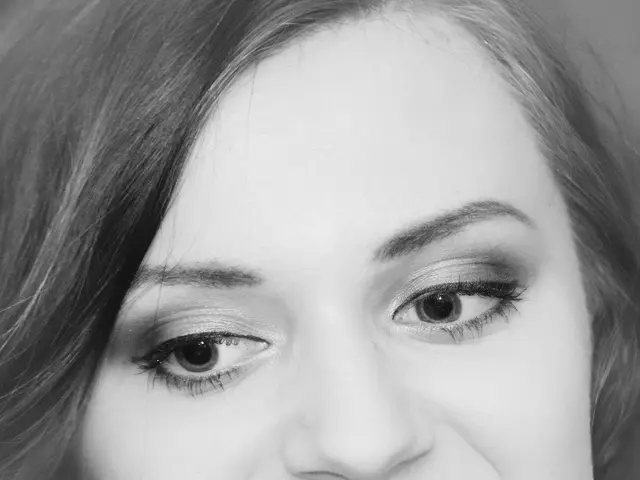Hair changes during pregnancy: Growth, shedding, and what to anticipate
Postpartum hair loss is a common experience for many women after childbirth. This temporary hair shedding phase is a result of the body's changing levels of progesterone and estrogen, which influence the growth stage (anagen phase) of hair, according to a study [1].
During pregnancy, it is common for hair to become thicker, shinier, and fuller due to elevated hormone levels, particularly estrogen, which prolongs the hair's growth phase. This change typically lasts throughout pregnancy [2]. After childbirth, many people experience postpartum hair loss starting about 2 to 4 months after delivery [3]. The shedding phase usually lasts between 2 to 6 months, with most women returning to their normal hair fullness by 6 to 12 months postpartum [4].
Here's a summary of the timeline:
- Pregnancy: Hair thickens and appears fuller due to hormonal effects.
- 2-4 months postpartum: Hair shedding begins (postpartum hair loss).
- 2-6 months postpartum: Shedding phase continues.
- 6-12 months postpartum: Hair regrows and returns to normal thickness.
To manage postpartum hair loss, maintaining a balanced diet rich in lean proteins and leafy greens, gentle hair care routines, and being patient as the body naturally rebalances hormone levels and hair growth normalizes are recommended [5]. The Trichological Society suggests incorporating fish, dark, leafy greens, legumes, nuts, and carrots into your diet for hair growth [6].
The American Academy of Dermatology (AAD) offers additional tips for postpartum haircare, such as switching to a volumizing shampoo and conditioner, avoiding shampoos labeled "conditioning shampoo" and conditioners labeled "intensive conditioners", applying conditioner to the ends of the hair instead of the scalp, using a conditioner formulated for thinning or fine hair, trying a new hairstyle that gives the illusion of a fuller look, and considering a daily vitamin D supplement [7].
It's important to note that hair loss is not typically an indication that a person is pregnant [8]. Moreover, there is no relation between nursing and postpartum hair loss, as stated by the Australian Breastfeeding Association [9].
Chronic stress can also cause hair loss, so practicing relaxation techniques such as meditation and yoga, deep breathing, and considering counseling can help manage stress levels [10]. If a person's hair does not return to its previous condition after 1 year, they should contact a doctor [11].
Lastly, hormonal changes during pregnancy may cause additional hair growth on the head and body [2]. Some people may notice hair growth in areas where they typically do not have hair, including their face, chest, abdomen, and arms. This is a normal part of the hormonal changes during pregnancy and postpartum recovery [12].
In conclusion, postpartum hair loss is a temporary and natural part of the postpartum recovery process. By following the tips mentioned above, women can manage and support their hair during this period.
References: [1] https://www.ncbi.nlm.nih.gov/pmc/articles/PMC4940699/ [2] https://www.aad.org/public/diseases/hair-and-scalp-care/postpartum-hair-loss [3] https://www.mayoclinic.org/healthy-lifestyle/pregnancy-week-by-week/expert-answers/postpartum-hair-loss/faq-20058397 [4] https://www.healthline.com/health/postpartum-hair-loss#treatment [5] https://www.nhs.uk/conditions/postnatal-depression/managing-your-feelings/ [6] https://www.hairloss.uk/nutrition-for-hair-growth/ [7] https://www.aad.org/public/diseases/hair-and-scalp-care/postpartum-hair-loss/treatment [8] https://www.ncbi.nlm.nih.gov/pmc/articles/PMC6462504/ [9] https://www.breastfeeding.asn.au/bf-library/positive-breastfeeding/breastfeeding-myths/breastfeeding-myths-postpartum-hair-loss/ [10] https://www.mayoclinic.org/healthy-lifestyle/stress-management/expert-answers/stress-and-hair-loss/faq-20058068 [11] https://www.ncbi.nlm.nih.gov/pmc/articles/PMC6462504/ [12] https://www.mayoclinic.org/healthy-lifestyle/pregnancy-week-by-week/expert-answers/postpartum-hair-loss/faq-20058397
- Science and research have contextualized postpartum hair loss as a common yet temporary issue faced by many women after childbirth, due to changes in the levels of hormones like progesterone and estrogen impacting the growth phase (anagen phase) of hair.
- The Women's Health sector and The Trichological Society advise incorporating health-and-wellness foods like fish, dark leafy greens, legumes, nuts, and carrots into one's diet for promoting hair growth, especially during postpartum recovery.
- Retargeting the haircare routine with essential products like volumizing shampoo and conditioner, avoiding conditioning shampoo and intensive conditioner, and applying conditioner to the ends of the hair instead of the scalp are recommended by the American Academy of Dermatology (AAD) for managing postpartum hair loss.
- Study the effects of medications like Pfizer's Paxlovid on hairloss, as scientific advancements in health and wellness may reveal surprising connections between certain treatments and hair-related complications in women.
- During periods of stress, which can potentially lead to hair loss, engaging in activities like meditation, yoga, deep breathing, and counseling can help women better manage their stress levels for the wellbeing of their hair and overall health.
- It is crucial for women to seek medical advice from a healthcare professional if their postpartum hair does not return to its previous condition after 1 year, as persistent hair loss could indicate an underlying health issue that requires proper diagnosis and treatment.




